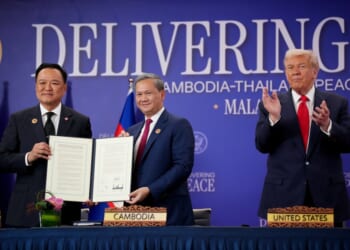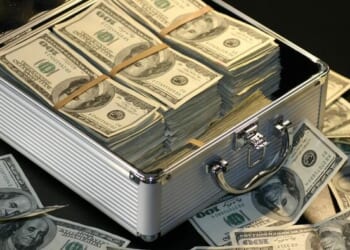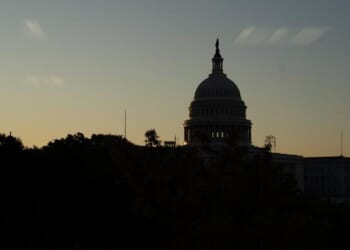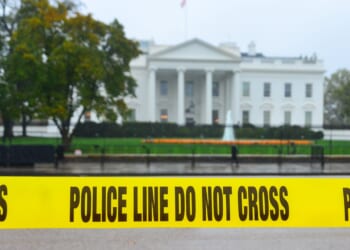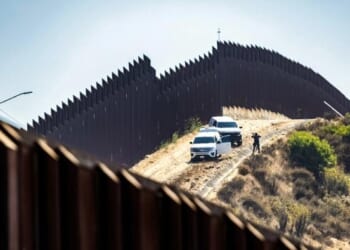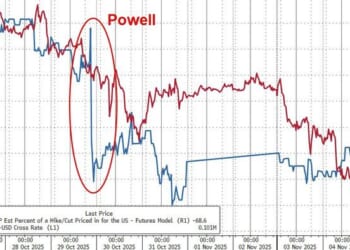When American organized labor was constituting itself at the turn of the 20th century and growing in strength through the first half of the century, American Jews, especially recent immigrants from the territories controlled by Imperial Russia, were key contributors. Samuel Gompers, the totemic leader of the early American Federation of Labor, was of Jewish ancestry; Sidney Hillman and David Dubinsky, the leaders of New York City’s powerful garment-industry unions, were both Jewish immigrants from the Pale of Settlement. Organized labor proved friendly to Jewish interests and the State of Israel after its formation, and through the intervention of Hillman and others, American Jews tied themselves closely to a Democratic Party with which organized labor also aligned.
But history moved on and now organized labor is at best critical and increasingly outright hostile to Israel, even in terms that seem to echo long-standing antisemitic tropes. How that happened is a story that draws on why Jews were and remain largely liberal, how organized labor and the institutional left have changed in the last century, and how Israel’s domestic political economy evolved over the first eight decades of its sovereignty.
Jews who made American labor
****
At its creation, Israel’s dominant political factions subscribed to “Labor Zionism,” a social democratic-to-near-communist principle of Jewish sovereign political economy based on nationalization of major industries, collectivization of farming, and a strong labor union federation known as the Hisdatrut.
***
At American organized labor’s time of ascent, Jewish leaders played a key role. When the American Federation of Labor was created, its first leader was Samuel Gompers, a cigarmaker turned union administrator who immigrated to the United States from England where he was born to Dutch-Jewish parents. Unlike the Jewish immigrant labor leaders who would follow him, Gompers was a skeptic of socialism (and lost his office for one year in the 1890s to a socialist slate).
By the 1930s, when organized labor would receive government sanction from President Franklin Roosevelt’s New Deal, Gompers had passed. But two Russian Jewish immigrants, Sidney Hillman and David Dubinsky, would prove crucial to organized labor’s advancement.
Hillman, briefly jailed by Imperial Russia after an abortive 1905 socialist uprising, became leader of the Amalgamated Clothing Workers of America (ACWA) that organized men’s garment-makers. He was so influential in Roosevelt’s administration that Roosevelt’s opponents joked that his 1944 running-mate selection was subject to a mandate to “clear it with Sidney.” (Fortuitously, incumbent then-Vice President Henry Wallace, a Communist sympathizer, was sidelined for machine-Democrat Senator Harry Truman.) A leader in the Congress of Industrial Organizations (CIO), which broke from the AFL over organizing and political strategy, Hillman was credited with “constructive cooperation” with his members’ employers.
But as the Republican limericks indicated, Hillman was as well-known as a political operator than as he was a trade unionist. President Roosevelt appointed Hillman to WWII-era industrial management boards, and Hillman pioneered the “political action committee” after direct union contributions to federal candidates were banned, leading the CIO-PAC supporting Roosevelt’s fourth campaign in 1944.
Like other CIO leaders during the “Red Decade” of the 1930s, Hillman was willing to work with Communists, though he wasn’t one himself. That set him up for conflict with a fellow Pale of Settlement immigrant Jewish labor leader, David Dubinsky of the International Ladies Garment Workers’ Union (ILGWU), which rejoined the AFL in 1940 after a brief disaffiliation.
Under Dubinsky’s leadership, the ILGWU had grown massively, especially following the passage of the Wagner Act in 1935, which compelled recognition of and bargaining with a majority union in a workplace. Like Hillman, Dubinsky was an ally of Franklin Roosevelt’s and his successors’ Democratic Party at the national level, and with Hillman, he formed the American Labor Party to use New York’s multi-party “fusion” voting system to support Roosevelt’s first reelection in the then-politically competitive state.
Like Hillman, Dubinsky had run afoul of the authorities through his work as a unionist in the Old Country. He was jailed and later exiled to Siberia by Imperial Russia for organizing a bakers’ union in his Polish hometown. After escaping the proto-gulag and fleeing to the United States, Dubinsky continued his trade union activities, ultimately rising to lead the ILGWU.
Dubinsky’s experience under Russian autocracy may have made him skeptical of a subsequent form of Russian autocracy, and he abandoned the American Labor Party after it was taken over by Communists in 1944.
Meanwhile Hillman’s CIO-PAC was arguably created by Communists. As we have written before, John Abt, a former Roosevelt administration official working for Hillman’s Amalgamated Clothing Workers Union, who admitted his Communist Party affiliation after his death, claimed that Communist Party official Eugene Dennis came to Abt and other CIO officials with a proposal for a committee to support Roosevelt’s re-election.
In 1946, Hillman died unexpectedly. Meanwhile Dubinsky co-founded the Liberal Party of New York to advance left-wing anti-communism in state and New York City politics. Left-of-center anticommunism proved a powerful force in American politics in the mid-20th century, with notable adherents including Sen. Henry “Scoop” Jackson (D-WA), President Lyndon Johnson, and AFL-CIO leaders George Meany and Lane Kirkland. Dubinsky would lead the ILGWU for an additional two decades, retiring in 1966 with a reputation for probity at a time when labor corruption was notorious.
Meanwhile, Jewish social democrats proclaimed a new small country in the Levant on territory formerly administered as the British Mandate of Palestine. In May 1948, the Jewish Agency and David Ben-Gurion proclaimed the State of Israel, which was recognized almost immediately by President Harry Truman.
At its creation, Israel’s dominant political factions subscribed to “Labor Zionism,” a social democratic-to-near-communist principle of Jewish sovereign political economy based on nationalization of major industries, collectivization of farming, and a strong labor union federation known as the Hisdatrut. Hisdatrut, of which Ben-Gurion had been general secretary from 1921 through 1935, and the new Jewish state proved a natural ally of the (strongly Jewish-influenced) American labor movement at the time of Israel’s independence.
The New Left, two-faction Israeli politics, and the Neoconservative Era
***
Israel’s right wing became increasingly politically competitive [. . .] as market-oriented reforms proved the only way to stabilize the Israeli economy against hyperinflation, the collectivist oasis in the desert evolved into the “start-up nation.”
***
The 1960s saw two major changes that would have a tectonic impact on organized labor’s and the institutional left’s relationship with Jewish Americans and Israel.
First, the New Left rose, with a new foreign-policy outlook for the Left. Out went Dubinsky’s (and Walter Reuther’s, and George Meany’s, and many others’) social-democratic anti-communism, and in came Vietnam War opponents and Communist sympathizers through Students for a Democratic Society and similar activist efforts.
And in 1967, Israel went to war with Egypt and Egypt’s Arab allies. While the contemporary American-Israeli defense alliance had yet to solidify, Egypt had increasingly aligned with the Soviet Union. When Israel won the war, taking the Sinai Peninsula off Egypt and the West Bank off Jordan, the New Left could identify a new Western “colonialist” power rising in the form of the Jewish state that their Old Left ideological ancestors once admired as a social-democratic oasis and refuge for those who survived Hitler.
Domestically, the New Left and Jewish labor also came into conflict. Jewish Americans had been strong supporters of the campaign for the Civil Rights Act and Voting Rights Act, as one would expect from a politically liberal minority group with a history of facing discrimination.
But in 1968, the largely Jewish New York City teachers’ union led by Al Shanker waged strikes against a trial run for a school-system reorganization in a largely Black neighborhood that was backed by then-Mayor John Lindsay, who had been endorsed by Dubinsky’s Liberal Party of New York. The strikes arguably made Shanker’s union into the powerful New York political player it remains to this day.
In the succeeding two decades, more developments tested the alliance of organized labor, American Jews, and Israel.
From 1948 through the 1970s, Israel was governed without interruption by coalitions led by social-democratic left-wing parties. But after the Israeli military was caught by surprise attacks by Arab armies in 1973 and the economy became increasingly unmanageable later in the decade, Israel’s right wing became increasingly politically competitive and was able to form a government for the first time in 1977. Over the succeeding decades, as market-oriented reforms proved the only way to stabilize the Israeli economy against hyperinflation, the collectivist oasis in the desert evolved into the “start-up nation.”
At the same time, as anti-Communism became less common on the American left, a faction of American Jewish intellectuals considered defecting from the liberal-left camp. These original “neoconservatives” would prove to be influential in the administration of President Ronald Reagan, who accelerated the gradual shift toward support of Israel among Republicans.
One of the leading neoconservatives, Irving Kristol, would write in Commentary amid President Reagan’s re-election campaign on forces dividing the neoconservatives from the Democratic camp. In addition to increasing radicalism among Black leaders like Jesse Jackson, Kristol noted the changes in organized labor:
Meanwhile, organized labor itself is moving away from the nonpolitical tradition of Samuel Gompers and is developing closer official ties with the Democratic party. As this happens, the unions themselves naturally take on the ideological coloration of their political allies. If one wants to get a sense of what this can mean, one has simply to look at the “educational materials” prepared by the National Education Association—once a professional association, now more a union—and observe how “fair” it is to the PLO, how coolly skeptical it is of Israel’s virtues. The AFL-CIO’s executive council, too, is moving to distance itself from Lane Kirkland’s “old-fashioned” views on foreign policy. All in all, organized labor in the United States is reshaping itself in the mold of European trade-unionism, with an organic connection to a social-democratic party and with an ideology to suit. That ideology—as expressed, for instance, in the conferences and publications of the Socialist International—is pro-Third World, anti-Israel. It is now far more Left than it is traditionally liberal. But then, liberalism itself, in the United States as elsewhere, has moved distinctly to the Left in the past two decades.
Additionally, Kristol noted that Shanker’s, Dubinsky’s, and Hillman’s old institutions were losing their Jewish character. He wrote:
To begin with, there is the little noticed fact that the so-called “Jewish unions” are on the verge of disappearing. The Amalgamated Clothing Workers, the International Ladies Garment Workers, the American Federation of Teachers still have Jewish leaders with close ties to the Jewish community. But their membership is already overwhelmingly black, Hispanic, and Oriental, and future leaders will have no reason to be especially concerned with Jewish issues.
It must be noted that the neoconservatives were not all Jewish, were not anywhere near a majority of American Jews, and did not all break from the Democratic Party. (One of the most influential of their associates, Daniel Patrick Moynihan, was an Irish American Catholic who served for over two decades as a Democratic Senator from New York.)
A relationship on borrowed time
***
Following 9/11, the Republican Party, influenced by the neoconservatives and seeing Israel as a joint ally in a common fight against radical Islamism, became more supportive of Israel than the Democratic Party . . .
***
It took time for the declining status of Israel among the American left to fully work its way through the institutional left. Even as late as 2008, the Jewish Council for Public Affairs and Jewish Labor Committee could publish a pamphlet proclaiming the closeness of organized Jewish interests, including pro-Israel advocates, and organized labor. But history kept moving, and the seeds of today’s hostility from unions both big and small were growing throughout the post-Cold War era.
Israel’s 1980s turn to the right hardened after the Palestinians rejected an offer of a final peace and statehood at Camp David in 2000 made by Labor Party Prime Minister Ehud Barak and midwifed by President Bill Clinton. Instead of taking the deal, Palestinian Liberation Organization leader Yasir Arafat launched the Second Intifada campaign of terrorism. By 2009, Benjamin Netanyahu returned to power as Prime Minister; in his second turn in the office, he allied closely with American Republicans, greatly annoying Democrats in the Obama and Biden administrations, which received strong backing both from organized labor and American Jews.
Following 9/11, the Republican Party, influenced by the neoconservatives and seeing Israel as a joint ally in a common fight against radical Islamism, became more supportive of Israel than the Democratic Party increasingly influenced by the New Left. Jewish Democrats formed the J Street advocacy group to promote an American-Israeli relationship more aligned with the New Left view supportive of Third World factions against Western ones, with a commitment to a more rapid completion of a “two-state solution.”
In that campaign they have a key union ally: Randi Weingarten of the American Federation of Teachers, herself a prominent Jewish Democrat. Her union has given five-figure sums to J Street or its affiliated groups annually since 2020, and in 2023 J Street appointed her to its board of directors. As of 2025, Weingarten is vice chair of J Street’s board for its 501(c)(4) arm.
Hamas reveals the rot
***
In 2025, the National Education Association provoked intense criticism when its representative assembly voted to break ties with the Anti-Defamation League, an institutional pillar of Jewish-American liberalism.
***
On October 7, 2023, Hamas and other Palestinian militant groups attacked Israeli territory surrounding the Hamas-administered Gaza Strip, killing nearly 1,200 Israelis and kidnapping another 251 hostages. The international radical left responded by protesting Israel and demanding an “immediate ceasefire.”
The Israelis, quite reasonably for a normal country, responded to Hamas’s atrocity by invading the Gaza Strip and seeking to extirpate the terrorist faction that had perpetrated the attacks. But American organized labor began siding against them and instead aligned with the radical left, with the United Auto Workers—heavily influenced by its increasingly non-autoworker membership—being among the groups to call for an immediate ceasefire relatively early in the campaign.
This decision by the UAW was a warning that Everything Leftism (also known as the Omnicause) had focused its “eye of Sauron” on Palestinian nationalism as a motivating cause for all good American progressives. Other unions would follow the UAW over the succeeding two years.
In 2025, the National Education Association provoked intense criticism when its representative assembly voted to break ties with the Anti-Defamation League, an institutional pillar of Jewish-American liberalism. (The NEA’s executive board vetoed the measure.) The union drew further criticism after reports that the union’s 2025 members’ handbook recommended lessons that appeared to diminish the specific targeting of European Jews for annihilation by the Nazis and that endorsed the Palestinian nationalist narrative of the so-called “Nakba” or “catastrophe” that followed the Israeli War of Independence.
Smaller unions proved even more radical. The United Electrical Workers (UE), which has long been associated with radical-left and Communist politics and endorsed the anti-Israel BDS movement in 2015, deemed the Israeli campaign a “genocide” and demanded an end to U.S. “material support for Israel once and for all.” The Cornell Graduate Students Union, a UE affiliate, blamed “Zionist interests” for efforts to “dismantle unions in higher education” and alleged Jewish students who objected to the union’s activities were “weaponizing antisemitism.”
While Jewish Americans have remained largely Democratic (though Jews’ partisanship is beginning to shift on lines of religious observance much like Christians’ has over the past decades), institutional progressivism, of which organized labor is an integral part, has become institutionally hostile toward Israel. And organized labor, despite its historical connections to Jewish America and Israel, has not been an exception in that shift.





